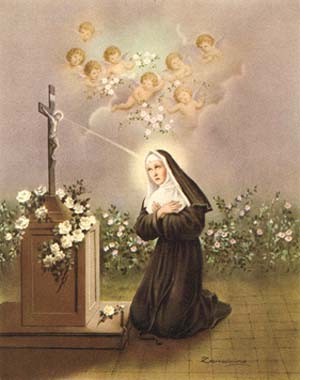St. Rita
In 1381 in a humble peasant home at Rocca Porena,
central Italy, there was born a little girl who was to attain a reputation
for great holiness on account of her mystical transports, her austerities,
and her long-suffering patience in meeting affliction. Rita, the child of
her parents’ old age, in youth demonstrated a strong religious sense.
When the time came for marriage, her parents forced her to marry an
unsuitable person, in spite of her desire to enter a convent. Rita
submitted sorrowfully, and the marriage proved to be one long torment.
Rita’s husband was brutal, dissolute, and uncontrolled; for eighteen
years she bore his insults and infidelities. With anguish she watched the
two sons of this union grow up in the likeness of their father. She wept
and prayed for them all three without ceasing. At last her husband came to
a realization of his sinful life, and begged Rita to forgive him for what
he had made her suffer. Soon after this he was killed in a brawl, and the
sons vowed to avenge their father’s death. Rita prayed that they might
die rather than commit murder. Then they both fell ill, and their mother
nursed them and brought them to a more forgiving state before they too
died.
 Left
alone, Rita now began to practice unusual austerities. She finally gained
admission to the Augustinian convent of Cascia, persuading the prioress to
overlook the rule that allowed her to accept only virgins. In 1413 Rita
received the habit of the order. She became quite pitiless in her
self-mortifications, scourging herself three times daily. Her charity
found an outlet in caring tenderly for other nuns in times of illness. The
contemplation of Christ’s sufferings would send her into ecstatic
transports. A suppurating wound on her forehead seemed to be connected
with her intense response to a sermon on the Crown of Thorns, an emblem
which had especial significance for her. During her later years Rita
suffered from a wasting disease, which was the cause of her death, on May
22, 1457. The first life of this saint was written in 1600. She was
canonized in 1900. Rita is joint patroness of a sodality which exists to
venerate the crown of thorns. Left
alone, Rita now began to practice unusual austerities. She finally gained
admission to the Augustinian convent of Cascia, persuading the prioress to
overlook the rule that allowed her to accept only virgins. In 1413 Rita
received the habit of the order. She became quite pitiless in her
self-mortifications, scourging herself three times daily. Her charity
found an outlet in caring tenderly for other nuns in times of illness. The
contemplation of Christ’s sufferings would send her into ecstatic
transports. A suppurating wound on her forehead seemed to be connected
with her intense response to a sermon on the Crown of Thorns, an emblem
which had especial significance for her. During her later years Rita
suffered from a wasting disease, which was the cause of her death, on May
22, 1457. The first life of this saint was written in 1600. She was
canonized in 1900. Rita is joint patroness of a sodality which exists to
venerate the crown of thorns.
The old tradition that associates roses and figs with
Rita has the following origin. Shortly before her death she asked a friend
to bring her a rose from her garden at home. It was not the season for
roses to bloom. Picking a rose and taking it back to the convent, she
asked Rita if she could get her something else. "Yes," was the
answer; "bring me back two figs from the garden." The friend
hastened away to the garden once more and discovered two ripe figs on a
leafless fig tree. Rita is sometimes represented in art as holding these
emblems. St. Rita of Cascia is especially venerated in Spain, and there
and elsewhere she has been called "the saint of the impossible."
In all countries persons who have especially heavy burdens to bear have
been comforted and helped by meditating on the example of this saint, and
praying to her.
— From Lives of Saints,
John J. Crawley & Co., 1954
|